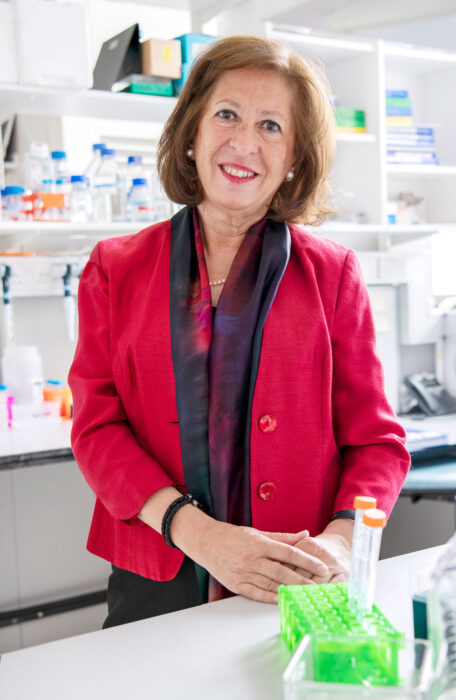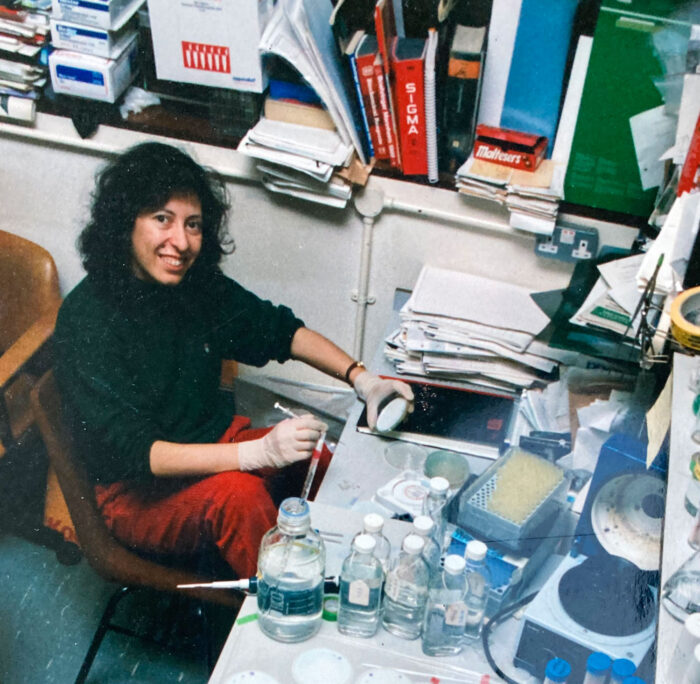Looking back: Maria Grazia Spillantini
Maria was a visiting scientist, PhD student and postdoctoral fellow in the LMB’s Director’s Division. She is now Professor of Molecular Neurology at the Department of Clinical Neurosciences, University of Cambridge.
For the 2021 LMB Alumni Newsletter, Maria shares some memories from her time at the LMB.

I joined the LMB in 1987 as a visiting scientist after graduating in Biological Sciences at the University of Florence in Italy. I grew up in Caprese Michelangelo, a small village in the Tuscan mountains where Michelangelo was born. It was impressive for me to be in Cambridge and at LMB, a place with so much history and people who had made fundamental discoveries in science. A few months after my arrival it was suggested that I could do a PhD, not available in Italy then, and so thanks to funding provided by Rita Levi-Montalcini, I started my Cambridge PhD in the Director’s division with Aaron Klug and Michel Goedert. It was an exciting time, Aaron had set up a group working to identify the components of the intracellular aggregates that form in brains of patients with Alzheimer’s disease. Several people were involved, each bringing complementary expertise: Claude Wischik and Ross Jakes extracting tissue; Tony Crowther analysing the filaments by electron microscopy; John Walker sequencing the protein fragments and Michael Novak and César Milstein producing antibodies. Michel Goedert was the molecular biologist of the group, and he identified the microtubule-associated protein tau. We then started to investigate tau isoforms in human brain and their modifications in Alzheimer’s disease. My role was to determine their expression and distribution. The work was very competitive and sometimes we worked overnight but there were always people around in the LMB, it was a very stimulating environment. The experience I gained on tau turned out to be critical as it later led to the understanding that something was wrong with tau in brains of patients and to the identification of one of the first mutations in the tau gene causing frontotemporal dementia and Parkinsonism linked to chromosome 17. While working on tau we also identified two proteins in human brain that we named alpha- and beta-synuclein. We later showed that alpha-synuclein is the main component of the filaments that form the Lewy bodies, the characteristic inclusions of Parkinson’s disease.

At the end of my PhD I went back to Italy having obtained a tenured research position at the National Research Council in Rome. However, I was missing the LMB environment, so I resigned my position and returned to LMB as a postdoctoral fellow with Aaron Klug. In 1996, I moved as postdoctor to the Brain Repair Centre of Cambridge University where in 2007 I became Professor of Molecular Neurology. I have continued to work on alpha-synuclein and tau aggregation focusing on mechanisms of toxicity and testing of compounds to prevent disease development. One of the compounds that we have shown to affect alpha-synuclein aggregation is now in clinical trials for Parkinson’s treatment.
The time at the LMB has influenced incredibly my way of thinking about science. I was part of the discussions with Michel, Aaron, Max Perutz, Tony Crowther, John Walker, César Milstein, Greg Winter, there was no apparent hierarchy. I was learning from the best. The LMB is a unique place, in a way which leaves a mark that influences the way of thinking scientifically and to question everything. Speaking at the annual Lab talks was a daunting experience.
The social events at the LMB were great, such as the unforgettable Christmas parties with César Milstein imitating himself and those in Nigel Unwin’s house. An episode that I vividly remember was during the 40th anniversary celebrations of the LMB, at a disco at Babraham, I ended up dancing with Francis Crick, who asked me if my supervisor had a simple mind, because this was essential for doing great science. This comment has remained with me.
Maria Grazia Spillantini, December 2021